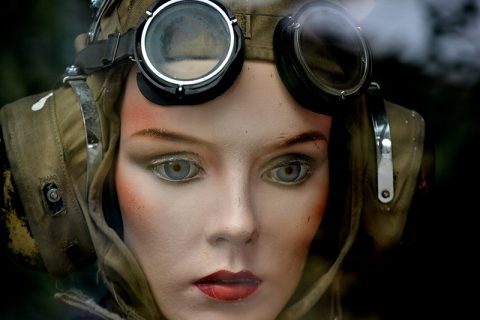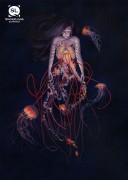I was struck by the vivid, anchoring images you have in this story especially the plastic buffalo figurine and the crossword puzzle. Can you talk a little bit more about your choices? Did you start with these images in mind or did they grow out of the premise?
The buffalo came first. I had been admiring a tintype by the photographer Derrick Burbul, who has a series called “Myths of the West,” which includes the photograph that accompanies the story. Immediately after seeing it, I felt the beginning of a story—something burning from all ends and creeping toward the center. It was frustrating and sad and inevitable, and those feelings evolved into the ‘You’ and ‘I’ of the piece.
I don’t really go into a story thinking about how a given image has a particular meaning. For me, that’s typically the work of revision and happy accidents. I had the buffalo, and several drafts in, I had the crossword puzzle. Both were important to the ‘I’ of the story, but I had difficulty in how I wanted to articulate that. This was mostly because I was dealing with the impulse to simplify them. Once I began to resist that urge, the image and the ‘I’ became more complex.
Much of the story is about the difficult work of memory and the pain of saying goodbye. It has the flavor of someone who’s been facing this finality for some time. That panic and powerlessness is what gives the piece its momentum. The irrational behavior is a natural response to death.
You received an MFA in Creative Writing from the University of Montana. Did your time in Montana have an impact on this piece?
I don’t think anyone who’s spent even a short amount of time in Montana can deny its effect. Life there can be ghostly and electric and have this feeling of operating outside of time. The scale of it is so immense, and avoiding it in your writing is no easy thing to do. I suspect nature played a big part in why I was chosen and nurtured by my colleagues and the amazing voices of David Gates, Debra Earling, Deirdre McNamer, Kevin Canty, and Prageeta Sharma. Each has spent a great deal of time coming to terms with what Montana means to them and their work. All I can say is that of all the places I’ve been or lived, it’s the one that keeps calling me home.
Tell us more about the novel you’re working on. Is your novel writing approach different from your short story writing process?
Call it superstition, but I’m a firm believer in not explaining too much about a piece before it’s been written. What I’ll say is that in novels and media, I’m a big fan of ensemble casts. I love community stories, and the novel is my opportunity to stretch out a bit and bring together a group of people in a way I just couldn’t achieve in a shorter format. I also enjoy the fantastic, and its relationship to sight and vision will play a role in the novel.
I approach most of my pieces rather organically. With a novel, however, I’m seeing the benefit of plotting and planning. I’m a sucker for Scrivener and the exceptional control it offers through some advanced organizational features. I’ve been working on variations of this story and its elements for a number of years, so being able to keep everything together is a definite bonus.
What book or short story or poem are you currently obsessed with?
I’m embarrassed to say that I’ve only recently come to the work of C.D. Wright, but everything I’ve picked up so far has driven me to find more. There’s something so deeply familiar and powerful about the voices she inhabits, and I’m glad that she can be with us in artifact, if no longer in body.
You mentioned a passion for strawberry-rhubarb pie. What makes the perfect slice?
Ice cold. Tart and sweet. Flaky as a Tinder date.


